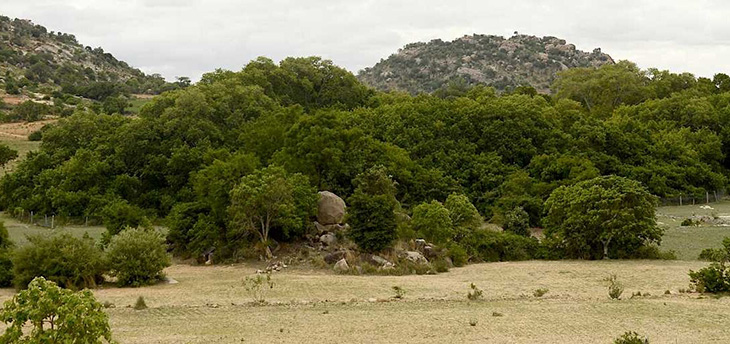

In the world of remarkable trees, North America often claims the spotlight. It is home to the oldest living single tree, the most ancient tree colony, the tallest tree, and the largest tree by wood volume.
Yet, for those seeking to stand beneath the grandest tree canopy on Earth, the journey leads not to the forests of California or the vast wilds of Alaska, but to the southeastern reaches of India. Here, in the state of Andhra Pradesh, thrives a living marvel: Thimmamma Marrimanu, also known as “Thimmamma’s Banyan Tree.”
This colossal banyan is not just an extraordinary tree but a wonder that stretches the imagination. Its canopy spans a jaw-dropping 4.7 acres (19,000 square meters), an area so vast it dwarfs many iconic structures.
To put it in perspective, its leafy expanse covers two and a half times the area of the Jefferson Memorial in Washington, D.C., and is four times larger than an average football field. So immense is its reach that standing beneath its limbs, one cannot hope to take in the entire tree at a single glance.
Gazing upward at the vast branches of Thimmamma Marrimanu, or ‘Thimmamma’s Banyan Tree,’ is an overwhelming experience, as its canopy extends so far and wide that it’s impossible to take in its full expanse from any single viewpoint.
At first glance, especially from a distance, the massive spread of greenery can easily be mistaken for a dense forest grove rather than a single organism. Walking amidst its countless trunks—over 1,000 in total—one might genuinely feel as if they are wandering through a woodland populated by many different trees.
Yet, this is an illusion. Thimmamma Marrimanu is one immense banyan, a single lifeform that defies typical perceptions of what a tree can be. As you walk among the twisting trunks that reach out like tentacles, it’s easy to believe you’re wandering through a grove—but that impression would be mistaken.
This ancient tree, estimated to be around 550 years old, belongs to the Ficus genus and has been revered for centuries. Its sheer size is even more impressive when compared to other famous trees.
The General Sherman Tree, a sequoia in California and known as the largest tree on Earth by volume, has a canopy that covers only 1,487 square meters. That’s less than one-tenth the area shaded by Thimmamma Marrimanu’s sprawling limbs.
To put the scale of this tree into perspective, consider that the General Sherman sequoia—the largest tree on Earth by volume—has a canopy covering only 1,487 square meters, which is less than one-tenth the size of the banyan’s vast spread.
The legend behind Thimmamma Marrimanu is as compelling as its physical stature. According to local Telugu folklore, the tree sprouted from a funeral pyre pole. A woman named Thimmamma, who lived during the 15th century, is said to have committed sati, the ancient and now outlawed practice of self-immolation on her husband’s pyre. From the ashes of this tragic act, the tree supposedly grew, carrying her name into posterity.
Unlike most trees that grow skyward from a single trunk, banyans like Thimmamma Marrimanu spread horizontally. As their branches extend outward, they drop aerial roots that descend to the earth and develop into strong supporting trunks. Over time, this allows the tree to cover vast areas while still being part of a single organism.
Unlike typical trees that grow upright from a single main trunk, the banyan tree follows a different growth pattern. Its massive branches extend outward horizontally, and from these sprawling limbs, it sends down aerial roots. Once these roots reach the ground, they take hold and develop into sturdy, woody pillars that support the ever-expanding canopy.
In the case of Thimmamma Marrimanu, this extraordinary process has resulted in the formation of more than 1,000 of these secondary trunks, each helping to sustain the immense weight and breadth of its vast network of branches.
Scientifically, banyan trees belong to a group known as strangler figs. These trees often begin life high up in the branches of a host tree, sending roots downward and gradually enveloping their host until they dominate the space entirely.

Over centuries, these roots and trunks fuse into complex structures that make it difficult to identify the tree’s original starting point. In this regard, Thimmamma Marrimanu might also be considered the largest parasitic organism on Earth. “It likely makes a good case of being the largest parasitical organism on Earth as well.”
Today, this remarkable tree thrives between two hills in a cultivated field, where it enjoys formal protection from the Indian government and heartfelt reverence from the local population. It is not only an ecological treasure but also a sacred landmark within the Hindu community. It could very well be considered one of the largest parasitic organisms on the planet.
The aerial roots play a crucial role in preventing soil erosion, while the expansive canopy creates a humid microclimate beneath, shielding the soil and preserving moisture through dry seasons. Many species of birds, insects, and animals find shelter in its branches, forming an entire ecosystem within the tree’s embrace. And for the people who live nearby, Thimmamma Marrimanu is more than a tree—it is a living symbol of the divine, deeply woven into their cultural and spiritual lives.
In a world where forests are rapidly diminishing, Thimmamma Marrimanu stands as a testament to nature’s enduring power and mankind’s capacity for reverence toward the natural world.
What are your thoughts? Please comment below and share this news!
True Activist / Report a typo






